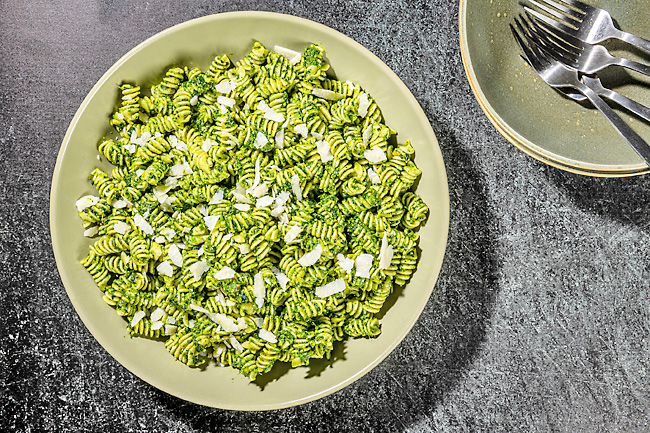G Daniela Galarza
THE WASHINGTON POST – When I was growing up, I knew kale only as the curly leaves that served as decorative dividers inside grocery store meat and deli display cases. At some point, when I was a young adult, kale turned trendy, and I started seeing it on restaurant menus and in glossy cookbooks, baby food and in all kinds of packaged snacks.
But those who keep a garden year-round know kale well. In the depths of winter, one of a gardeners’ last spots of green will be the kale patch.
“On a blustery winter day, it’s not uncommon to find me out in the garden, brushing the snow off the kale I plan to fix for dinner,” wrote Marian Morash in The Victory Garden Cookbook.
Morash noted that kale can withstand a severe frost, and it’s even easier to grow than cabbage. She supplies all kinds of ideas for what to do with it, but her strongest recommendation is to blanch the thick leaves in heavily salted water until they wilt but still hold their bite. Dressed with chilli oil or lots of lemon juice, topped with a tadka or a fried egg, it makes a simple side dish or even brunch.
But drop that blanched kale into a food processor or blender with garlic, nuts, olive oil and Parmesan cheese, and you’ve got a pesto made of winter’s deepest green, full of round, bold flavours and a texture that’s pleasantly velvety.

It’s great stirred into soup or risotto, makes a lush topping for crusty bread, can be stuffed into a sandwich, used as a marinade or drizzled atop roasts. But, as with pesto Genovese, it’s an ideal sauce for pasta.
The Italians knew this first, of course. Cavolo nero, or Tuscan kale, generally doesn’t grow south of Rome. Like all kale, it’s said to turn sweet right after a frost, when it’s picked and then blanched, braised or turned into thick soups like ribollita and farinata di cavolo nero, a porridge-like dish with polenta and Tuscan kale.
But we’re after pesto di cavolo nero. It’s an old Tuscan recipe, said to be popular when the season’s fresh olive oil, pungent and green, makes an especially good marriage with the hardy leaves of cavolo nero. Countless cookbooks have published recipes for the saucy, cold-weather pesto.
I found this recipe for kale pesto, below, buried in The Washington Post’s archives from 2008. It was adapted from one published in The Real Dirt on Vegetables by John Peterson, and its ingredients and method agree with all of the other variations on kale pesto I’ve seen over the years.
And while it’s ideal on pasta, don’t let that stop you from using it to top your morning eggs or savoury oatmeal, stirring it into soup or braised beans, adding a touch of vinegar to turn it into a dressing for salads or using it as a dip for or drizzle atop roasted vegetables.
KALE PESTO
30 minutes
Makes one and a third cups
Storage Notes: Refrigerate for up to five days.
INGREDIENTS
– Two quarts water
– Two teaspoons fine salt, plus more as needed
– Eight ounces kale, preferably lacinato, thick stems removed and leaves coarsely chopped
– Two cloves garlic, smashed
– Quarter cup chopped walnuts, toasted (see NOTE)
– Half cup extra-virgin olive oil, plus more as needed
– Half cup grated Parmesan cheese, plus more as needed
– Freshly ground black pepper
DIRECTIONS
In a large pot over high heat, bring the water and salt to a rolling boil. Meanwhile, in a large bowl, prepare an ice bath.
Add the kale to the boiling water and cook, uncovered, until tender, about five minutes.
Using a slotted spoon or spider, transfer the kale to the prepared ice bath and let cool completely, then strain and, using your hands, squeeze as much water from it as possible.
In a food processor, combine the garlic, walnuts and kale and whiz until well combined.
Pour in the oil in a steady stream, and pulse until a smooth puree forms. If the pesto seems too thick, add additional oil until it reaches your desired consistency.
Transfer the pesto to a medium bowl and stir in the cheese. Taste, and season with additional cheese and/or salt, and pepper, if desired.
NOTE: To toast walnuts: Heat a heavy skillet, such as cast-iron, over medium heat. Add the chopped walnuts and stir constantly until they start to brown and become fragrant, about five minutes. Alternatively, place them on a baking sheet and toast at 325 degrees for five to 10 minutes. Keep an eye on them as they can burn quickly, which will make them taste bitter.






